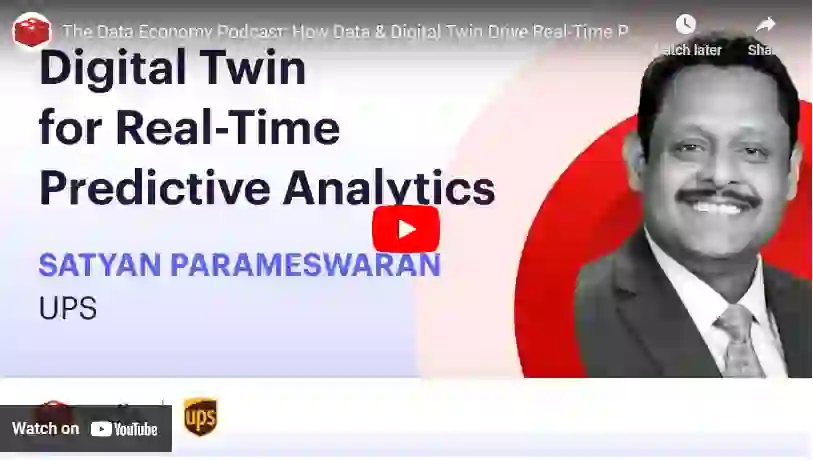
Learn more

The Data Economy is a video podcast series about leaders who use data to make positive impacts on their business, customers, and the world. To see all current episodes, explore the podcast episodes library below.
“We are an engineering company at heart and hide all the complex things we do in the back so that it looks very simple.”
That’s how Satyan Parameswaran, President of UPS Information Technology, describes the mission and culture at UPS. Satyan was a recent guest on The Data Economy, a podcast presented by Redis and hosted by Michael Krigsman of CXOTalk. He shares several fascinating insights into how a logistics company drives customer satisfaction, addresses new market opportunities, and improves its reputation using data.
Behind the scenes are several impressive technologies, including a digital twin, advanced real-time experience technologies, internet of things (IoT) devices, and predictive analytics capabilities that help UPS manage a complex logistics network.
Their operation certainly looks simple when a smiling driver delivers your important packages every morning, but behind the scenes, it is a complex logistics function operating in 220 countries and over 2,000 facilities. The company delivers 26 million packages and documents per day, and on any given day, there can be 50-60 million packages in transit, generating over 1 billion event data points.
And what keeps Satyan up at night? The team behind the scenes at UPS knows they must scale and serve global customers while keeping costs intact. When the global demand for shipping fluctuates daily, and when there are all kinds of logistics issues, including extreme weather, flight delays, and power outages, UPS has the incredible challenge of predicting what resources they need across their facilities and network.

Satyan and a multidisciplinary team of developers, process engineers, and data scientists turned up the heat—quite literally—and developed a harmonized enterprise analytical tool (HEAT), a digital twin that operates in real-time and predicts the resourcing needs at its facilities.
A digital twin is a real-time model of a physical system or process. Developing digital twins requires modeling the underlying systems and sharing real-time data with them to create predictions. Digital twins are often used to simulate real-world conditions for prototypes, such as jet engines and building architectures, but UPS uses its digital twin in a production process to predict demand and provide facility directors with recommendations on resourcing needs.
Satyan says, “To gain confidence, we have to predict at the mid-to-high 90%. It helps us manage the network, which is the living, breathing thing that allows us to move packages so that we do not disappoint the customers. Our multidisciplinary team started with the process engineers and created a product that actually works; otherwise, it would look like a science project.”
Satyan provides many insights and advice to CIOs, CTOs, architects, and technology leaders on bringing real-time experience platforms like digital twins and machine learning models from the lab to production. That’s key because a recent study on bringing AI from experiments to production found that 88% of decision-makers expect increases in AI/ML use cases, but 40% believe their current data architectures won’t meet their future model-inferencing requirements.
According to Satyan, “If you are not capturing and interpreting data quickly, you might lose the context of what the data is trying to tell you.” He recommends having a strong focus on data quality because having “tons of data does not mean that you have high-quality [data].”Real-time experiences and data processing capabilities used to be goals of only the most advanced financial services, digital advertising, gaming, and other tech-savvy companies. Today, more companies recognize the importance of developing advanced real-time experiences that use search, recommendation engines, time-series analysis, and graph databases. For example, retailers are developing real-time inventory systems, crop insurers are collecting real-time data from drones, and hospitals are transforming the patient experience.
The world needed UPS’s technology and logistics capabilities to deliver vaccines to over 100 countries at over 99.99% reliability. UPS’ smart labels, a real-time IoT built on RFID technology that UPS has been iteratively improving since the mid-1990s, were fundamental to building a self-declaring package required for healthcare. “We didn’t anticipate that the world would go through COVID, and we were just getting prepared to deliver healthcare products at scale.”
And isn’t that the point of developing scalable, real-time experiences and accelerating innovations? Because as technology leaders, we just don’t know what the next business opportunity will require, but we do know that high-quality, reliable, and real-time analytics are the baseline engineering capabilities. Tune in to the podcast to hear more of Satyan’s insights on creating an engineering and analytics culture that brings emerging technologies like digital twins and IoT RFID devices to deliver significant business outcomes.
Watch more episodes of The Data Economy podcast.